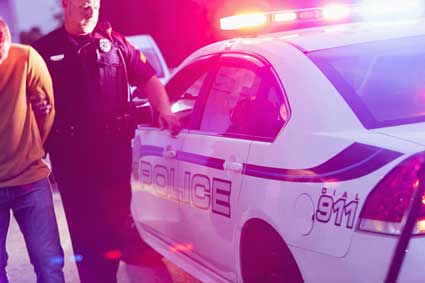Evidence from a crime scene carries the largest impact on the minds of many law enforcement personnel, as well as lawyers and judges and juries in a court of law. The physical, tangible evidence produced by any crime; photographs, fingerprints, hairs, blood and fibers, often points with unerring accuracy to the guilty party. However, if such evidence is not properly collected from a crime scene, it not only becomes inadmissible, but also may serve to sway opinion against the law enforcement agency that collected it, as well as create an impression that the entire case built against a suspect is built upon a house of cards.
Physical evidence may be used to prove the guilt or innocence of a suspect, as well as to confirm or deny statements, alibis and motivations for any crime. In addition, the use of physical evidence may help in re-creating the crime scene so that investigators may get a better idea of what happened and why.
- Be identified
- Be relevant
- Meet legal collection requirements
- Show that chain of custody protocol has been followed
Therefore, all evidence needs to be marked to show its original location at the crime scene. Making notations on the collection container or tube as well as the crime scene investigator's notes and evidence log can achieve this requirement. The name of the officer who collected the evidence must also be noted, as well as the date, time and case number assigned to the investigation. A brief description of the evidence should also be noted.
Packaging must be completed according to departmental policy and collection method protocols. Each piece of evidence must be packaged separately in order to prevent cross-contamination. Following collection, each package must also be sealed in order to prevent handling, as well as to save and protect such evidence. In the cases of biological evidence, coolers or freezers are essential to preservation and to prevent degradation over months and years. Care must be taken when packaging all materials for short-term or long-term storage, and proper departmental procedure must be followed in order to preserve the integrity of the evidence.
All physical evidence must follow its own specific disposition, or handling and final resolution or location. This typically starts with the investigating police department's lab, where it may either be stored in the Property Clerk's Office or be sent out to further testing at state or even FBI labs.
Regardless, it is essential that thorough records are kept showing chain of custody for the evidence, and follow that evidence thorough every step of the analysis and investigative process.
The chain proves the integrity of the evidence and must be shown. In most law enforcement agencies, the person collecting the evidence, as well as anyone taking custody of it, even for brief time periods, must always note the following pieces of information:
- Name or initials of person who collected evidence
- Date the item was collected or transferred
- Name or initials of any person or official who takes custody of evidence in any way
- Name of the originating agency, assigned case number and type of crime
- Victim or suspect name
- Description of the evidence
For example, unidentified fibers may be found at a crime scene. The local police lab is unable to identify them. The crime scene investigator turns over all evidence collected at the crime scene to the local department property clerk, who then signs for "receipt" of materials. If that evidence needs to be submitted elsewhere for testing, the department property clerk must sign a "release" for the evidence, and the person receiving the evidence at the FBI testing lab for example, must sign "receipt" of materials once again. In this way, the evidence is "followed" from its original collection at a crime scene to wherever it needs to go in order to be properly processed and analyzed. Eventually, and in most cases, the evidence will make its way back to the original investigating department where it is stored for a required number of years.
The most common method still used by law enforcement departments around the country, and the world, consist of the "mechanical" method. This is the method used when a crime scene investigator employs the use of fingerprint power or stains and a fingerprint brush. Commonly called "dusting for prints", the investigator uses a brush to physically work a fingerprint medium over a smooth surface to "lift" a fingerprint. This technique will cause particles in the fingerprint powder to adhere to the moisture left on ridges in the fingerprint. Of course, this method works best on smooth, non-porous surfaces such as glass, tile and many types of wood and wall surfaces.
Equipment used in this type of process includes a wide variety of powders, brushes and lifting tapes. Fingerprints lifted on tape are then mounted on special cards that in many cases look like common receipe or note cards. The print is affixed to one side, while the other side will record the date of the lift, which investigator or technician who lifted the print, the agency, department case number and location of the lift.
Different law enforcement departments employ different policies regarding how prints are to be lifted, mounted and photographed. However, after the card has been completed, it is placed in a bag or envelope and sealed with evidence tape and marked with the investigator's initials.
It is important that a crime scene investigator properly protect him or herself from contamination of such fluids, not only to prevent cross-contamination of the evidence, but also as protection from AIDS, hepatitis, tuberculosis and other communicable diseases. In addition, it is wise for a CSI or technician to avoid sneezing, talking and coughing when victim or suspect DNA might be present to prevent accusations of cross-contamination. No smoking, no eating, no drinking should be allowed near any core crime scene area.
Protective clothing such as booties to fit over shoes, and special suits or lab coats or aprons that protect clothing are an important part of any CSI's crime scene kit. Eye protection as well as masks and gloves are also essential and should always be worn. If the crime scene incorporates more than one room or location, always discard and change gloves before moving on to a new area within the crime scene.
DNA evidence may be obvious and collection of such objects as teeth, bone and hair is rather straightforward, though collection of evidence such as saliva or sweat or skin cells is more difficult.
Scraping, swabbing, taping or collecting the item can accomplish collection of blood and body fluids. For example, when collecting dried blood or tissue samples from an object, scraping the tissues or blood with a scalpel or scraping device works quite well. Samples are gathered in paper or tissue and placed into an evidence envelope and documented.
Swabbing is the most common technique used to collect various samples of DNA evidence. A cotton swab or Q-tip is moistened with saline solution and then dipped into or gently rubbed over the surface of the sample to be collected. It is then sealed in an evidence envelope or tube and documented.
A third method to obtaining DNA tissue samples is through "lifting". Dried stains can be lifted with a standard latent tape or other lifting medium, which is placed on the stain and then lifted, with particles or latent evidence adhered to the sticky surface of the tape. The tape is then placed in an evidence envelope. However, this method is not commonly used in many departments due to the amount of time it takes lab personnel to separate the lifted materials from the adhesive on the lifting tape.
Collecting trace evidence requires a bit more time, equipment and skills on the part of the crime scene investigator. Trace evidence, remember, may be considered hairs and fibers, glass, and flecks of paint. Many such samples of trace evidence are very difficult to find, let alone collect. However, the identification and collection of such evidence must be completed first, before it is ruined or destroyed by weather elements or inadvertent cross-contamination by investigating personnel at a crime scene.
When collecting hairs and fibers, the most common tool used in their collection is a tweezers. However, other equipment is sometimes used, including vacuums, lifting tapes and tissue paper.
Hairs and fibers can be seen rather easily on clothing and should be collected using tweezers and tissue paper. This can be accomplished by holding the tissue in one hand while the other retrieves the evidence with the use of a tweezers. The hair or fiber should be placed immediately in the tissue, folded and placed in an evidence envelope.
When collecting any clothing objects, from undergarments to shirts and jackets and trousers, very carefully fold clothing articles in on themselves to preserve evidence. Do not shake or otherwise jar materials or the crime scene investigator may lose valuable evidence. Place in a large envelope, box or bag and seal.
Physical evidence should not be handled any more than absolutely necessary, and crime scene investigators as well as other personnel must always remember to wear gloves or use tools to prevent contamination when handling any type of evidence.
























